My interest in chickens was renewed as soon as I read the second section of The Omnivore’s Dilemma a few years ago. Circumstances prevented me from doing anything about that until this year, though. I will be chronicling the entire adventure on here from May 26th when they arrive until late July when they make the move to the freezer. If things go well, I’m also considering getting turkeys for the fall, but that’s a while away :)
Growing up, we had chickens for quite a few summers but my memories consist of keeping the chicks in the basement for a week or two, occasionally playing with them outside in the summer, and then eating them in the fall and winter. The care, feeding, etc. has long vanished to be replaced with developer-related information (more recently dealing with the the stupid intricacies of SSIS). Luckily I live in a fairly rural area and have been lucky enough to meet several people who will be able to mentor me throughout the upcoming months.
The approach I’ve chosen is Joel Salatin’s pastured poultry (also originally described in Michael Pollan’s book). Instead of having a run, the chicks are put into a enclosure that is moved (at least) once a day. This gives them access to fresh grass, bugs, etc. and reduces the chances of disease (and smell). They can only get about 20% of their diet from nature so grain is still required – even here there better choices to make than what large-scale productions do. (I will probably write more about large-scale farming and egg production later, but not now.)
The “portable enclosure”
Although Joel writes about the cage in more detail in Pasture__d Poultry Profits, there are still some questions about how exactly to do certain things. (‘Cage’ is apparently a four-letter word in some circles, so I am searching for an alternative). I am not a carpenter, nor even handy, so getting the first side to stand on its own was a pretty exciting experience :) The second one went a lot more quickly.
The biggest problem so far has been finding galvanized aluminum for the roof. I’ve given up for the sides and purchased flat sheets of aluminum but they strike me as a bit expensive. The cage seems fairly sturdy even without the roof and bottom wire – below you can see the current state with places for the doors in the bottom left quadrant.
The “traditional housing”
The chickens arrive on May 26th and will probably spend a week to ten days in the basement under a heat lamp. Before I can start moving them around in the portable enclosure they will need a week of adjustment to the temperatures – this is where the chicken house + traditional run comes in.
We decided to clear out the shed and section off about 60% for the chickens. There will be three dozen and I think this will be more than enough space for the time they’re in the shed. Check out the before and after pictures below. I’m particularly proud of the door (and learning what L-braces are for :))
Inside the shed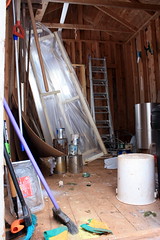 |
Finished chicken partition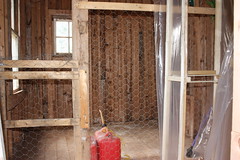 |
The entire photo set for both chicken housing areas is available here
How much did it cost?
I have done some rough calculations comparing the cost of materials, chickens, feed vs. buying the meat from even the grocery store (which is far from a fair comparison) and the numbers are extremely encouraging. I will do a much more detailed cost-benefit later, but let me quickly outline what has been purchased so far. These prices do not include taxes.
- 10 pieces 2x2x8 – $16.90
- 10 pieces 1x3x8 – $17.92
- 8 pieces 1x3x10 – $11.20
- 10 ft 1/16” cable – $2.30
- Turnbuckle – $2.09
- 1/2 lb. 3” screws – $6.39
- Wood laths (bundle) – $9.99
- 1”x21 Gauge chicken wire, 20’ – $7.80
- Aluminum coil stock, 20’ - $45.98
A chunk of that wood was for the portable greenhouse, and there were some 2.5” and 1” screws we had to buy as well. All together we’re looking at about $100 to build the pen plus whatever the roof costs. I’m hoping to get some scrap aluminum for that, but we’ll see. This is for an 8’x8’ enclosure; Joel’s classic Polyface model
What’s next?
Obviously the biggest concern is getting the roof completed. It would be really helpful if I could find a source of aluminum somewhere on the island as the flat stuff is not going to work well with the rain unless I fiddle with the design. You can see from the picture linked at the end of the last paragraph how the grooves would help.
I will probably stick with the basic feed the local CO-OP sells for this summer, although I’ve already been given some advice for mixing in other ingredients to help with cost (and better nourishment). The final part will be figuring out exactly where to do the slaughter – there are a few options and people to talk to but luckily I have until late July to sort that out. Get ready for tons of pictures of chickens come late May!

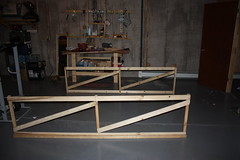
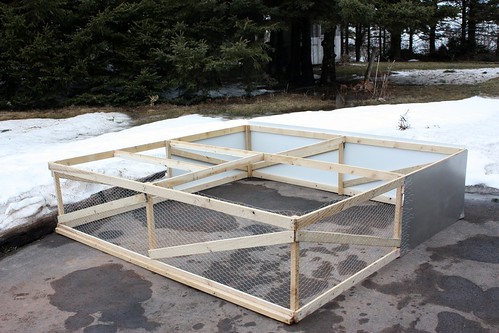
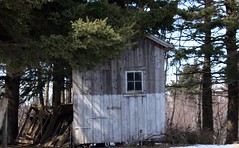
Comments